Speaker
Description
Physics-enforced neural-network inelastic material models guarantee adherence to the laws of physics, even before training. There are currently two main approaches to enforce this, either by using neural networks with convexity restrictions to model thermodynamical potentials (known as Physics-Augmented Neural Networks, cf. [1]), or by embedding neural networks in the evolution laws such that positive dissipation is ensured by construction (cf. [2]). The similarities and differences between these approaches, in the context of plasticity and viscoelasticity, will be highlighted in this talk. Furthermore, the possibilities for discovering interpretable material models from these neural networks are discussed.
[1] Rosenkranz, M., Kalina, K. A., Brummund, J., Sun, W. C., \& Kästner, M. (2024). Viscoelasticty with physics-augmented neural networks: model formulation and training methods without prescribed internal variables. Computational Mechanics.
https://doi.org/10.1007/s00466-024-02477-1
[2] K. A. Meyer and F. Ekre, “Thermodynamically consistent neural network plasticity modeling and discovery of evolution laws,” J. Mech. Phys. Solids, vol. 180, p. 105416, 2023,
https://doi.org/10.1016/j.jmps.2023.105416.

